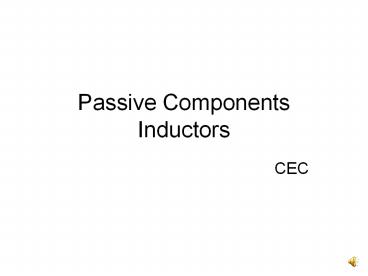Passive Electronic Components - Inductors. PowerPoint PPT Presentation
Title: Passive Electronic Components - Inductors.
1
Passive ComponentsInductors
- CEC
2
Contents
- Introduction
- Inductor Types.
- Fixed Inductors.
- Variable Inductors.
- Working Principle.
- Applications.
3
Inductors
- Passive component, exhibits reactance.
- Back EMF generated opposes change in current.
- Inductance measured in Henry.
- Specifications include inductance, current rating
and tolerance. - Important characteristics temperature
coefficient of inductance, Q-factor, working
frequency range, stability, dc resistance of
windings etc.
4
Inductors
- Can be classified based on the type of core used.
- Air Core Inductors, Iron Core Inductors, Ferrite
Core Inductors, Powder Core Inductors etc. - Transformers, Chokes Intermediate Frequency
Transformers (IFT) etc. - Transformer action based on mutual induction.
5
Inductor Types
Inductors
Air Core
Iron Core
Ferrite Core
Powder Core
Fixed Inductors
Variable Inductors
Antenna Coils
Up/DownTransformer
IFT
RF Transformer
Autotransformer
Chokes
Oscillator Coils
Power Transformer
AF Transformer
6
Inductor Colour Coding
7
Inductor Colour Coding
Exercise Colour Code a 680 µH 10 Inductor.
8
Air Core Inductors
- Thin copper wire wound over thick
cardboard/plastic (former). - Low value of inductance.
- Suitable for radio frequency applications.
9
Iron Core Inductors
- Copper wire wound on a laminated iron core.
- Laminated core has thin iron sheets pressed
together and insulated, minimises eddy current
losses. - For audio frequency applications.
10
Ferrite Core Inductors
- Coil wound over ferrite core.
- Core movable in variable type.
- For frequency tuning.
11
Powder Core Inductors
- Powdered iron core.
- Low core losses at a given frequency.
- Low permeability.
- For high frequency applications.
12
Chokes
- RF chokes can block high frequencies, pass lower
audio frequencies and dc. - AF choke can block audio and power line
frequencies, allow dc to pass. - Variable RF chokes available.
13
Transformers
- Two or more coils, induce energy from one circuit
to another. - Works by the principle of mutual induction.
- Can step up/step down voltages.
- Change in current induces a magnetic flux in the
core. - Core common for primary and secondary windings.
- Voltage induced in the secondary windings.
14
Transformers
15
Power Transformer
- Step up number of turns in secondary higher
than in primary. - Step down - number of turns in secondary lower
than in primary. - Step down transformers used in power supplies,
step up in distribution networks. - Regulation - ability to maintain rated output
voltage under load, expressed as percentage.
16
Power Transformer
17
18
Intermediate Frequency Transformer
- Tuned to work at 455 KHz using 40 pF capacitance
across primary/secondary winding. - 455 KHz known as intermediate frequency in AM
radio receivers. - Permeability tuning.
- Initial adjustment may be required to tune to 455
KHz. - Aluminium can enclosure.
19
Intermediate Frequency Transformer
20
Audio Frequency Transformer
- In AF applications for voltage/ current/impedance
transformation. - Input transformers couple low impedance source
(eg microphone) to high impedance circuits (eg
amplifier). - Output Transformers match high impedance sources
(eg amplifier) to low impedance loads (eg
loud speaker). - Provides isolation and impedance match.
- Used in public address systems, radio receivers.
21
Audio Transformers
22
Autotransformers
- Electrical transformers with only one winding.
- Three terminals, one variable.
- Auto" means single coil acting alone, not any
kind of automatic mechanism. - Portions of the same winding act as both primary
and secondary windings. - Smaller, lighter, and cheaper than typical
dual-winding transformers. - No electrical isolation between primary and
secondary circuits.
23
Autotransformer
Rotary Arm
Windings
24
Autotransformer
25
Inductor Testing
- Open circuit By continuity check with Ohmmeter/
Multimeter. - Shorted/Partially shorted Found by inspecting
the high frequency response. - Partial shorting reduces high frequency roll off.
- Measurement Using LCR/Inductance meter,
Experimental calculation using - bridge circuits (Maxwell, Hay, Owens etc.)
26
Inductor Ratings
- Wire gauge and physical size of the coil
- determine the current handling capacity.
- Core material will have a temperature
- dependence.
- Temperature variability due to changes in
- the permeability of the core material with
- temperature.
- Air core inductors most stable, followed
- by iron powder, then ferrites.
27
Inductor Handling and Installation
- Inductors not polarized, may be installed
- in either direction.
- Inductors not generally susceptible to
- static electricity, special precautions not
- required.
- To minimize mechanical stress due to
- lead bending.
- In timing/frequency determining circuits
- to be installed in a mechanically rigid
- fashion.
- Melted beeswax prevent mechanical
- shifting of windings.
28
Thank You

